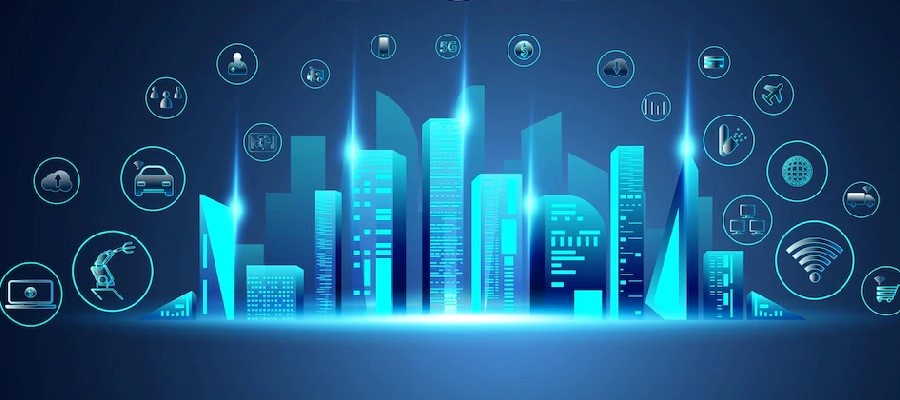IoT Security In Smart Buildings
Security follows functionality. After all, manufacturers want to stand out from the competition with the numerous functions. With IoT apps, however, the security aspects should have top priority in order to be successful as a manufacturer in the market in the long term.
The Internet of Things (IoT) is a great opportunity for many areas in industry, smart cities, MedTech and smart energy. The networking of production facilities is a key step on the way to Industry 4.0, and the potential for increasing efficiency seems immense. The majority of industrial companies therefore want to invest in IoT technology in the next few years.
Smart buildings cause lower maintenance costs, are more efficient and even more convenient for users in many ways. Operating processes can be continuously optimized using Building Information Modeling (BIM). But are smart buildings also safe? Yes, provided that manufacturers and operators of IoT applications consistently pay attention to cyber security.
While private apartments are becoming smarter thanks to digital networking (smart home automation), public real estate is already one step further. The new technological trend for functional buildings such as office complexes, shopping centers, train stations, airports or convention centers is called smart building. The networking goes beyond individual residential or usage units and connects relevant sensors and systems of the entire building with one another.

Enormous potential for operators and users
The potential of intelligent buildings is enormous: Thanks to the possibilities of the Internet of Things, physical systems and virtual applications can be networked. Smart buildings gain huge amounts of data from this. If they are centrally recorded, analyzed, compressed and made available system-wide, remarkable optimizations can be achieved, which in many cases run fully automatically. Some examples:
– The heating output is reduced when the windows are opened.
– The light is switched off where nobody is.
– The rooms provide the data basis for efficient use and cleaning.
– Devices determine error states themselves.
– Systems report in advance when they need to be serviced.
On the one hand, the operators of smart buildings benefit from these advantages because energy efficiency increases, downtimes are minimized and maintenance costs are reduced; on the other hand, the technology also benefits users by providing more comfort and security.
Business optimization through Building Information Modeling (BIM)
So-called Building Information Modeling (BIM) can be used to make full use of the possibilities of smart buildings. All building data — from the planning phase through construction to operation are recorded, networked and visualized. This gives the building a digital twin that operators, users and service providers can use to optimize day-to-day operations. In buildings with a large number of visitors, such as train stations and airports, such a BIM is already used to better guide the flow of people.
The fact that functional buildings are usually used by many people also brings with it difficulties in terms of data protection law: The collection of personal data not only requires good reasons; Transparency is also required with regard to the type of data, the storage location, access by third parties and the length of time until data is deleted.

Protection of the entire IoT ecosystem
In addition to personal data protection, cyber security is also essential in a smart building. Because from the merging of information and operational technology systems, from the networking of IT and OT (Operational Technology), a complex IoT ecosystem is created. With all of its sensors, actuators, monitors, Internet interfaces and external components, such an overall system offers a multitude of points of attack for cyber-attacks. The risk of data misuse or manipulation is increasing sharply.
For operators of smart buildings, the IoT security of the integrated devices must therefore have absolute priority — because with networked systems, only one weak point is needed to make the entire network vulnerable. This must be considered when purchasing each individual IoT component.
Security throughout the entire product life cycle
Manufacturers of IoT devices, on the other hand, must pursue a consistent “security by design” approach. That means: Aspects of IT and OT security are already very important in the development of IoT devices. Cyber security remains central throughout the entire product life cycle, i.e. from the product idea to the decommissioning of a device. Because the ever more numerous and constantly changing interfaces constantly bring new cyber risks with them, which must be countered with adequate and effective measures.
“Security by Design” therefore also means that the necessary security measures are implemented within an IoT device, i.e. in its hardware and IoT embedded software. This can be achieved through secure architectures, secure update mechanisms, verifiable and auditable processes and through a strong separation of the components.
Create a competitive advantage with IoT security
A top security solution brings in-depth expertise to support manufacturers and operators of IoT devices on the way to secure IoT ecosystems and thus also to secure smart buildings. This guarantees solutions with the highest possible, sustainable and comprehensive cyber security.
As a manufacturer of IoT applications, you can only retain customers from industry in the long term if you give your product the necessary priority to comprehensive security issues. The later in the development process the security is introduced, the more complex the serious product launch on the market or with your customer will be. In order to bring the necessary security into a product efficiently and cost-effectively, the motto in product development for product managers and developers must be “Security by Design”. Hyperlink InfoSystem can assist you with an excellent secured IoT solution.
Disclaimer: Being a follower of ‘The IoT Magazine’ offers lots of perks. A consultation session with experts from across the industries is a major one. Submit your query here and we will connect you with the right IoT experts. He might be sitting next door, you never know.

